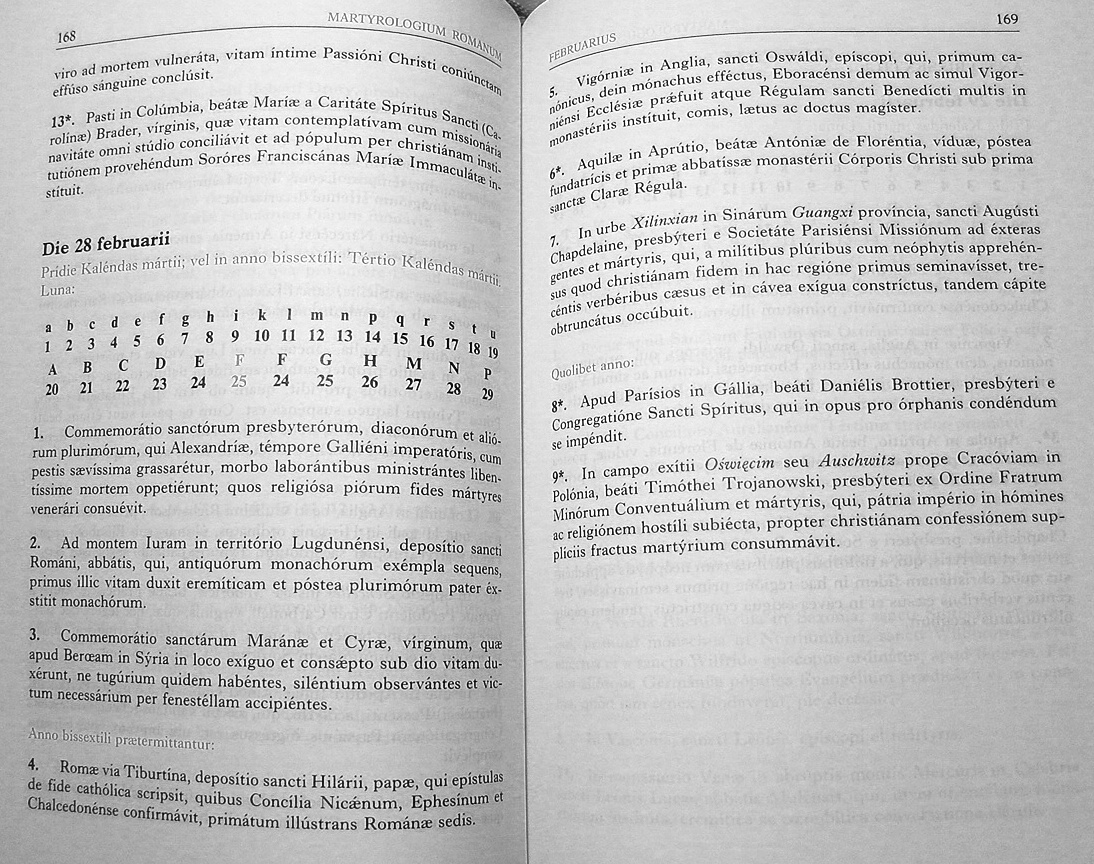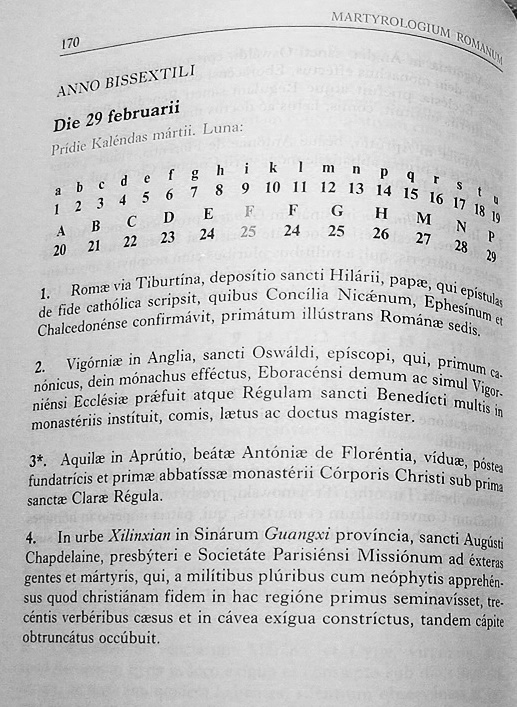From Fr Z's Blog
It is a Leap Year Day. In Latin this is bissextilis, and has nothing to do with prominent Jesuits and their abetters.
When there isn’t a 29 February, the saints are observed on 28 February. For this intercalary day in the Roman Martyrology we find this:


In 46 BC, on the advice of the Alexandrian astronomer Sosigenes, G. Iulius Caesar created a calendar system that added one day every four years to make up for the fact that the Earth’s year is slightly more than 365 days. Your planet circles your yellow Sun in slightly more time than it takes for your Earth to rotate 365 times (365.24219). Calendar years with 365 days drift from the actual year by about 1 day every 4 years. After a while the month named after Caesar, July, occurred during the winter (in the Northern hemisphere).
Caesar’s Julian Calendar was maintained until 1582 when Pope Gregory XIII determined that in his Gregorian Calendar leap days would not occur in years ending in 00, unless the year is divisible by 400. And we do have a Jesuit, a serious one, to thank for the Gregorian Calendar.
When the Roman Senate renamed the month Sextilis to honor Augustus, they borrowed time from February to make August longer than July (after Julius, formerly known as the fifth month, Quintilis). So, February wound up being shortened.
Sextilis, the day, was six days before the kalends (1st) of March (inclusive) = 24 February. Hence, in the traditional calendar St. Matthias was celebrated on 25 rather than 24 February during leap years.
The intercalary month that the Romans used to try to keep the civil calendar in sync with the solar calendar was inserted around the festival of Terminalia on the 23rd. In the reform of the calendar, one day was inserted behind the 23rd of February every three or four years. It was the “double sixth day” or bis sextilis. Bis sextilis and sextilis (the 24th and 25th to us) were considered as one day long day.
Whereas in most years the calendar is advanced one day at a time, in a leap year there is a week in which a day is advanced two days. In 2012 Christmas (25 December) was a Tuesday. In 2013 a Wednesday. In 2014 a Thursday. In 2015 a Friday. In 2016 Christmas falls on Sunday, not Saturday. You can see the “leap” in the calendar.
Anyway… it’s complicated.
Some time ago, I received a good explanation in an email from the British Library:
In 1582, calendrical reform came from Rome again, this time, from Pope Gregory XIII (1502-1585). Gregory realised that because a whole day was added to every fourth year, when in fact it should be a bit less than a day to be accurate, the Julian calendar was 11 days ahead: 15th October in Gregory’s time was, astronomically, 4th October. In order to cut out this accumulated surplus, he issued a Papal directive stating that 4th October in 1582 will be followed by 15th October and the first year of each century will not be a leap year any more, except if it is divisible by 400. So what about the leaping saint? Well, the medieval solution for the leap-year problem was generous. By doubling 24th February the following saints’ feast days could all keep their original date and – because there were two 24ths in the month – February remained 28 days long. In this way, no saint suffered the ignominy of having their feast day celebrated only one year in every four. Instead, there was a gain: in the leap year Saint Matthias was celebrated twice – on the 24th(a) and 24th(b) alike.Yet curiously, in this overhaul the repeated 24th remained in place. It was only over time that the medieval system of two 24ths was phased out and replaced by a 29th day of the month, but the tradition of having an extra 24th with its leaping saint, the Apostle Matthias, is still preserved in the Catholic liturgy.
Finally, two items of interest.
Ash Wednesday has not yet fallen on a 29 February and it won’t until 2096.
And, as you know, tidal friction in the system of your planet and its moon slows your planet’s rotation down so that a day is lengthened by some 1.4 milliseconds per century. In about 4 million years, we can stop with the bissextilis, though some Jesuits will probably still be saying that it’s okay.
Happy Bissextilis!
No comments:
Post a Comment
Comments are subject to deletion if they are not germane. I have no problem with a bit of colourful language, but blasphemy or depraved profanity will not be allowed. Attacks on the Catholic Faith will not be tolerated. Comments will be deleted that are republican (Yanks! Note the lower case 'r'!), attacks on the legitimacy of Pope Leo XIV as the Vicar of Christ, the legitimacy of the House of Windsor or of the claims of the Elder Line of the House of France, or attacks on the legitimacy of any of the currently ruling Houses of Europe.